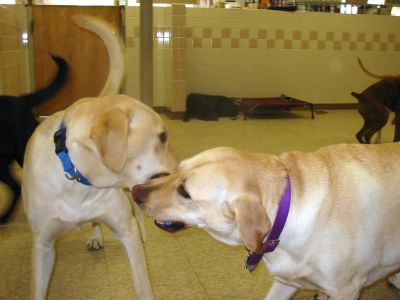How we raise, train and socialize our dogs has a huge impact on how they behave. If they have been well treated, all dogs, regardless of breed, have the potential to be well-behaved, and pleasant to live with. Getting a dog there may be more difficult with some than with others, depending on their natural tendencies. For example, labrador retrievers have the potential to be wonderful family dogs. However they have a HUGE amount of energy when they're young, and if not strenuously exercised on a regular basis they tend to be nudgy, nervous, clumsy, bossy, and generally a pain in the neck.
So when does a dog's behavior become a problem? Sometimes it obvious, like if she steals food off "people surfaces" (counters, tables). Or jumps on every guest who comes to your house. However, sometimes we wonder if our pup is behaving "normally", meaning are they behaviorally healthy?? For example, what about a dog who startles easily? Or one who cannot stand to let you out of his sight? Or we might wonder if its normal for Fluffy to pee on the living room rug when there are workmen in the house.
Here are some indicators of canine behavioral health:
- Friendly toward people she meets, including well-behaved children.
- Friendly toward other friendly dogs, both those he lives with and those outside the family.
- Will readily give up control of food, toys, and other desired objects.
- Can be left alone for reasonable periods of time without panicking.
- Is relaxed during normal, everyday handling and touching: wiping her feet, brushing her coat, looking in her ears, looking in her eyes.
- Calms down quickly after being startled if there's no cause for alarm.
- Barks when necessary or appropriate, but will stop when told to.
- Plays well without becoming too rough.
- Doesn't damage his owner's possessions.
- Is affectionate without being needy, clingy, or annoying.
- Can adapt to changes such as travel, movement, confinement to a carrier with minimal problems.
If your dog doesn't meet half or more of these criteria, she needs help, preferably from a trained canine behaviorist who's willing to meet with you and your pet in your home to determine what factors might be altered to support changes her behavior. Of course, all of the criteria are not of equal importance. If your dog growls at friendly strangers, he needs immediate help, even if he meets all of the other criteria. Some of the criteria on the list may be less important to you than others, depending on your lifestyle. For example, if you have small children it is crucial that your dog not guard his possessions. Toddlers must be able to approach a pet that is eating without getting bitten! On the other hand, if you live in the country and/or your neighbors don't complain, you may be tolerating an abnormal amount of barking, simply because you've never trained your dog to stop when told.
And, no it's not healthy for a pet to pee on the carpet when there's a stranger in the house, or for her to leap up in a fright when someone drops something nearby.










